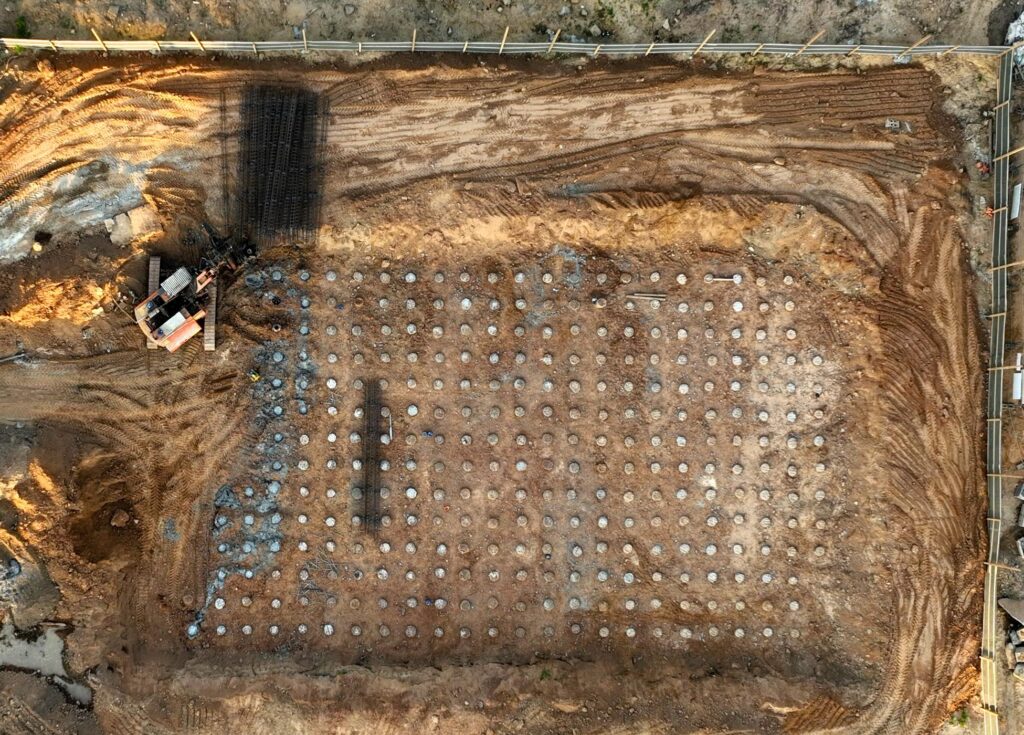
Introduction
If you’re a landowner, developer, general contractor, architect, or structural engineer who actually wants to get the most for your money when it comes to foundations and earthwork, this article’s for you.
This discussion is about value engineering at its finest: understanding when a deep foundation is truly necessary and when smart collaboration can save you a fortune.
Why We Go Deep — and Why We Often Don’t Need To
Every geotechnical engineer has experienced this:
You ask the structural team for service loads so you can design a foundation that actually makes sense.
And you get one of these responses:
“The load is equal to the foundation area times the allowable bearing capacity.”
“Just design for 4,000 psf and we’re good.”
“I’ll give you the maximum column loads — that should be fine.”
Cue the sigh.
Those answers don’t just make design harder — they make projects more expensive. When geotechnical engineers don’t have the right data, we’re forced to assume worst-case conditions. “Conservative” in this context means over-designed and over-budget.
Ironically, over-designed foundations often perform worse, not better.
The Science (and Art) Beneath the Surface
Unlike steel or concrete, soil is not predictable. Two sites with the same classification can behave completely differently under load. That’s both the challenge and the thrill of geotechnical engineering.
A solid process always includes:
- Understanding your soil. Gather data, perform testing, and determine its engineering properties.
- Staying shallow if possible. Spread footings (with ground improvement if necessary) are almost always more cost-effective.
- Controlling settlement. Especially differential settlement between adjacent foundations.
That last part -controlling settlement -is impossible to do accurately without the actual service loads. Without them, we’re guessing. And those guesses cost money.
Deep Foundations 101
Deep foundations are designed to transfer loads from a structure down to stronger soil or rock layers well below the surface. They come in several forms:
- Pile Foundations: Long, slender columns (steel or concrete) driven or drilled deep into the ground.
- Caisson Foundations: Large, hollow boxes or cylinders sunk to depth and filled with concrete — ideal for bridges or waterfronts.
- Drilled Shafts: Bored, reinforced, and poured in place to carry immense loads.
- Buoyancy Rafts / Basement Foundations: Used when soil is soft; the structure “floats” in balance with its own weight.
These systems are engineering marvels – but only when they’re actually needed.
A Real-World Example (and a Half-Priced Solution)
A few years ago, my team was asked to design a ground-improvement system for a large structure in clayey soils.
The initial data package gave us:
- A pile layout,
- A target allowable bearing pressure, and
- The standard “1 inch max total settlement” criterion.
No actual service loads.
We ran a conservative design. The resulting estimate could have made the evening news.
Weeks later, the client provided the real service loads — including which foundations resisted uplift, shear, or moment. With that information, we optimized the system.
Result: Half the original cost and a shorter construction schedule.
Accurate information didn’t just save money – it made the structure better.
When Deep Foundations Are the Right Choice
Deep foundations earn their keep when:
- The near-surface soils are weak, compressible, or variable.
- The structure carries heavy vertical or uplift loads (bridges, high-rises, tanks, etc.).
- Groundwater or erosion risks make shallow options unstable.
When designed correctly, they provide outstanding performance – strength, durability, and resilience. But if your project doesn’t demand it, you’re simply paying for depth you don’t need.
A Better Way to Build
The smartest projects happen when geotechnical, structural, and architectural teams collaborate early.
When the right information flows both ways, the design is more efficient, the cost lower, and the performance more predictable.
At Garbin GeoStructural Group, we take pride in spending our clients’ below-ground dollars as carefully as our own.
We’ll always try to keep structures shallow when it makes sense — using innovative ground-improvement solutions to make challenging soils behave.
And when deep foundations are the right answer, we design them to match the real loads, not hypothetical ones.
Conclusion: Teamwork Saves Money
Great engineering isn’t about overdesigning -it’s about precision and collaboration.
Provide your geotechnical engineer with the right data, and you’ll get a safer, more cost-effective project.
Knowledge is power. Good data is money saved.
About Garbin GeoStructural Group
Garbin GeoStructural Group is a nationally licensed engineering firm specializing in innovative geostructural design, including:
- Ground improvement,
- Deep foundations, and
- Earth-retention systems.
Working with only the most skilled specialty contractors, we deliver turn-key, cost-effective geotechnical solutions for challenging sites nationwide. Contact us today to ensure your foundations are optimized for performance and cost.
